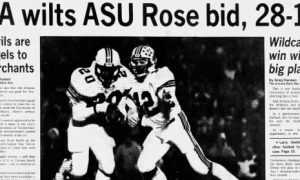
EDITOR’S NOTE: Due to the controversy surrounding Sean Miller’s technical foul in last year’s Pac-12 Tournament, an event in which former Pac-12 director of officiating Ed Rush reportedly placed a bounty on Miller to be thrown out or given a technical, this site will monitor the league’s officials during the course of the season through the conference tournament in March. The integrity of the game and its officiating was called into question by Rush’s actions, which ultimately led to his resignation.
Through the first half of the Pac-12 season, it’s evident that when a game of significant magnitude is played, the most experienced and efficient refs are not always there.
Two veteran refs — Verne Harris and Tony Padilla — were assigned to the important Pac-12 matchup between the Arizona Wildcats and Stanford on Thursday, but the other official (Shawn Lehigh) worked only his third conference game of the season.
Harris has worked eight this season and Padilla, one of the refs to work the Pac-12 tournament title game last year, has officiated four.
This is how wacky the scheduling is for Pac-12, Mountain West and WAC officials: Harris flew to Las Cruces, N.M., after the Arizona-Stanford game and officiated the Cal State-Bakersfield game against New Mexico State on Thursday night. Instead of flying Harris to Eugene, Ore., for the important game between UCLA and Oregon, he was in Las Cruces. Figure that one out.
Want more wacky?: In another key matchup in the Pac-12 on Wednesday between ASU and Cal, one official (D.G. Nelson) worked his first Pac-12 game of the season while Rick Hartzell and Brett Nansel were assigned to only their second. In their last two games, the Sun Devils have drawn three refs making their conference debut of the season — Nelson, K.C. Ely and Rodrick Dixon — but Herb Sendek doesn’t mind because ASU won both against Cal and Colorado.
It’s obvious the schedule for the refs is made well in advance of the games.
Whistle-happy: Bob Staffen averages a league-high of 44.5 personal fouls called in games he works. He also tops the league with teams combining for 56.3 free-throw attempts a game.
Biggest homer?: David Hall added to that distinction in the USC-Oregon State game on Thursday with the host Beavers having nine less fouls than USC. Oregon State, which won 76-75 in overtime, also attempted 14 more free throws. Hall leads the league in home teams having 34 less fouls called in the seven games he has worked. He also is atop the conference with home teams taking an astounding 51 more free throws.
Hall has worked three Oregon State games in Corvallis, the only ref to be assigned that many times to one location this season. A technical foul was called on USC’s Omar Oraby, which means Hall’s crews have called a league-high two technical fouls (the other was on ASU in its game at UCLA).
Thick-skinned: Mike Scyphers’ crews have called 18 more fouls on home teams in five games. Also in games he officiated, the home team has shot 24 fewer free throws. If I am a visiting coach I’d want to see Scyphers out there.
Most used: Harris is second only to Randy McCall, who has officiated nine Pac-12 games. He also worked the USC-Oregon State game Thursday.
The following five charts involved a few hours of my time putting together data of league referees. I will update the data through the season. Here is a brief description of each:
Chart 1 and 2: Chart 1 indicates the referees who have officiated at least three Pac-12 games in the first four weeks of the season. Chart 2 lists all officials.
Within Chart 2, it first lists the years the referees have worked college basketball games per statsheet.com.
The conference record shown indicates the cumulative combined conference records of the teams at the time they played in the game called by the ref.
The “Rank” column is the number of games called that involve AP Top 25 teams. Also listed are stats related to games called by a referee’s crew: Personal fouls, average of personal fouls, disqualifications, technical fouls, free-throw attempts and free-throw attempt average a game.
Other columns: PFDiff — Difference between fouls of home and away teams (a minus score reflects more calls made for the visitor), and FTDiff — Difference between free-throw attempts of home and away teams (again, a minus score reflects more calls made for the visitor).
Chart 3 and 4: Chart 3 indicates the number of overall games called by a ref of a particular conference team. Chart 4 has the same principle but indicates only certain locations where the referee called a game.
Chart 5: Indicates difference of calls made for a team at home compared to on the road in Pac-12 games. HPFDIFF stands for “Home Personal Foul Difference” compared calls to visitors. HFTDIFF stands for “Home Free Throw (attempts) compared to visitors. The same principle applies for when on the road for APFDIFF and AFTDIFF. The total of each category is signified with TotPFD and TotFTD.
CHART ONE: MOST-USED OFFICIALS
[csv src=http://wildaboutazcats.net/wp-content/uploads/2014/01/Pac12RefsMostGames8.csv]
CHART TWO: ALL OFFICIALS
[csv src=http://wildaboutazcats.net/wp-content/uploads/2014/01/Pac12RefsOverall8.csv]
CHART THREE: REFS BY TEAMS CALLED
[csv src=http://wildaboutazcats.net/wp-content/uploads/2014/01/Pac12RefsAllGames8.csv]
CHART FOUR: REFS BY LOCATIONS CALLED
[csv src=http://wildaboutazcats.net/wp-content/uploads/2014/01/Pac12RefsRoadGames8.csv]
CHART FIVE: DIFFERENCE OF CALLS HOME AND AWAY
[csv src=http://wildaboutazcats.net/wp-content/uploads/2014/01/HomeAway8.csv]
WILDABOUTAZCATS.net publisher, writer and editor Javier Morales is a former Arizona Press Club award winner. He also writes articles for Bleacher Report, Lindy’s College Sports and TucsonCitizen.com.
[rps-paypal]
|
|






















